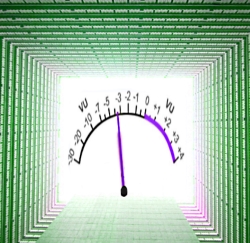I know it may be hard to believe, but I too used to believe this was true.
I had simply never given it much thought. Maybe you’re in the same boat?
The issue was, I made the mistake of confusing headroom with dynamic range.
Put simply, when I looked at the master fader, if there was a lot of room between the loudest peak of my mix and 0 dBFS (clipping, the part where the red light comes on), then I assumed my mix had plenty of dynamic range.
I imagined my mastering engineer opening up the mix, smiling to himself and saying, “Man, that Joe has done it again. Look at all this dynamic range!” Wrong.
It turns out I simply had a fundamental misunderstanding of dynamic range. I would hear engineers lament the fact that people were over-compressing their mixes, the so-called “loudness wars.”
Everyone was in a craze of adding a big, fat limiter to their mixes to make them super-loud.
The problem is that volume and dynamic range are two very different things. Volume is how loud something is. You could measure the average volume of a song, for example.
Dynamic range measures the difference between the loudest and softest sections of a song.
Let’s say you’re working on a song that has a very soft section with just a vocal and a quiet guitar, then a huge full-band section right afterward.
Is the quiet section just as loud as the full-band section? If so, you’re probably over-compressing something. The quieter part needs to be quieter, or it just sounds unnatural…and un-musical.
As we know, compression reduces dynamic range. So, being able to measure dynamic range allows us to see if we’re over-compressing our mix. Of course, you can use your ears, but sometimes our ears can be deceiving.
I personally use the TT Dynamic Range Meter to check my mixes, but to each their own.
The Take-Away
Perhaps you don’t want to bother with a dynamic range meter. That’s fine, but here’s the point I’m trying to make.
Just because your mix is quiet doesn’t mean it isn’t over-compressed.
You could have a mix that peaks at -10 dB on the master fader. Does that mean you have a dynamic range of 10 dB? Nope. That just means you have 10 dB of headroom.
Does that mean you’ve left your mastering engineer plenty of room to work? No!
Let’s say that mix peaks at -10 dB, but you’re using a bus compressor to completely squash the mix. Your mix could have no dynamic range. Just because it’s quiet doesn’t mean it’s dynamic.
The moral of the story? Don’t over-compress. If you think you’re over-doing it, you probably are. Take a step back. Be conservative. You’re mixes will thank you.
Are you watching your dynamic range?
Joe Gilder is a Nashville based engineer, musician, and producer who also provides training and advice at the Home Studio Corner.















